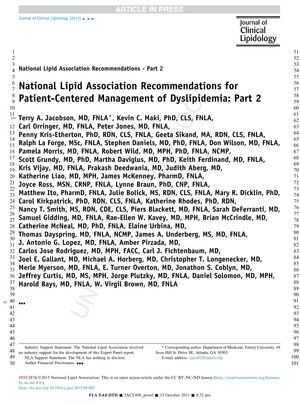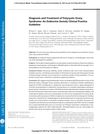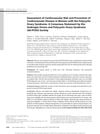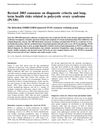National Lipid Association Recommendations for Patient-Centered Management of Dyslipidemia: Part 2
November 2015
in “Journal of Clinical Lipidology”

TLDR The guidelines suggest lifestyle changes, diet adjustments, and personalized medication to manage dyslipidemia and reduce heart disease risk.
In 2015, the National Lipid Association issued comprehensive guidelines for the management of dyslipidemia, emphasizing a patient-centered approach that includes lifestyle modifications, pharmacotherapy, and consideration of individual patient factors. The guidelines recommended dietary changes such as reducing intake of cholesterol-raising fats and adopting Mediterranean or vegetarian diets to lower the risk of atherosclerotic cardiovascular disease (ASCVD). They also suggested the inclusion of plant sterols and viscous fibers to reduce LDL cholesterol and the use of omega-3 fatty acids to decrease the risk of coronary heart disease (CHD). For patients with high triglycerides, a diet rich in whole grains, legumes, unsaturated fats, protein, and fiber was advised, along with regular physical activity and calorie control. The guidelines also addressed the management of dyslipidemia in specific populations, including children, adolescents, pregnant women, older adults, and those with HIV or rheumatoid arthritis, recommending tailored approaches for each group. Additionally, the guidelines supported the use of combination therapies, such as adding ezetimibe or PCSK9 inhibitors to statins when necessary, and highlighted the importance of medication adherence for achieving treatment goals. The document also recognized the benefits of team-based care in improving patient outcomes and satisfaction.
View this study on lipidjournal.com →
Cited in this study

research Diagnosis and Treatment of Polycystic Ovary Syndrome: An Endocrine Society Clinical Practice Guideline
The guideline suggests using specific criteria to diagnose PCOS, recommends various treatments for its symptoms, and advises screening for related health issues.

research Assessment of Cardiovascular Risk and Prevention of Cardiovascular Disease in Women with the Polycystic Ovary Syndrome: A Consensus Statement by the Androgen Excess and Polycystic Ovary Syndrome (AE-PCOS) Society
Women with PCOS should be screened for heart disease risk and manage their health to prevent it.

research Revised 2003 consensus on diagnostic criteria and long-term health risks related to polycystic ovary syndrome (PCOS)
The 2003 consensus updated PCOS diagnosis criteria and linked PCOS to higher risks of diabetes and heart problems, recommending lifestyle changes to lower these risks.